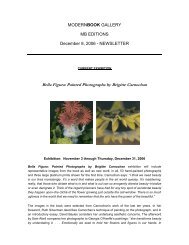THE MIND'S EYE
THE MIND'S EYE
THE MIND'S EYE
Create successful ePaper yourself
Turn your PDF publications into a flip-book with our unique Google optimized e-Paper software.
community in the 1960s are now appearing in the mass media, in relation to the increasing prominence of electronically generated<br />
composite images.<br />
Yet these images resist easy categorization: to label<br />
Uelsmann a surrealist, a pantheist, a mythologist, or a diarist is to disregard<br />
other, equally significant aspects of his work. What seems inarguable is that, in<br />
addition to proving the validity of his approach by producing imagery that at its<br />
best is unsettling, enchanting, magical, and oddly melancholy, Uelsmann has<br />
demonstrated a remarkable consistency of vision. Again and again in his imagery,<br />
a lonely and often shadowy male figure (a stand-in representing the photographer)<br />
searches convoluted, mysterious, multi-dimensional scapes pervasively animated<br />
by the Feminine, seeking contact with the Other. Fundamentally, he’s a wanderer<br />
through inner space, a lyric poet using a new language to recount his adventures.<br />
And part of the pleasure of engaging with Uelsmann’s photographs is that the<br />
dance of symbols therein never seems theory-driven, intellectualized, or otherwise<br />
forced, but emerges, unpremeditated, through play and experiment.<br />
Due to the omnipresence of digital imaging systems today,<br />
darkroom-based photomontage as a craft can already be considered archaic.<br />
(Indeed, the Rochester Institute of Technology, where Uelsmann studied the<br />
medium as an undergraduate, will begin to teach gelatin-silver printing itself as an<br />
“alternative process” in the fall of 2008). Ironically, versions of the disputes that<br />
took place over Uelsmann’s early imagery within the microcosm of the photography<br />
P 14<br />
It seems to be Uelsmann’s fate to have established darkroom-generated photomontage as legitimate and viable<br />
within classic photographic practice by bringing it to its pinnacle of virtuosic expression, only to witness the obsolescing of that practice in<br />
its entirety by the onslaught of electronic imaging. In that sense, he constitutes a<br />
terminus. But we can also view him as a springboard: in building a wide international<br />
audience for his own imagery and encouraging his colleagues in their parallel<br />
experiments, he helped prepare that receptive soil in which computer-generated<br />
imagery has now taken root.<br />
Yet, as long as he’s permitted to pursue his own inclinations,<br />
he doesn’t appear to regret that cultural transition. This was never a man spoiling<br />
for a fight over what was or was not permissible in creative photography, merely<br />
someone whose vision carried him into one. Still, it’s safe to say that no future<br />
study of the history of photomontage will be considered seriously unless it takes<br />
the theory, the practice, the teaching, and—most importantly of all—the imagery<br />
of Jerry Uelsmann into account.<br />
© Copyright 2008 by A. D. Coleman. All rights reserved. By permission of the author and Image/World<br />
Syndication Services, imageworld@nearbycafe.com.<br />
P 15







